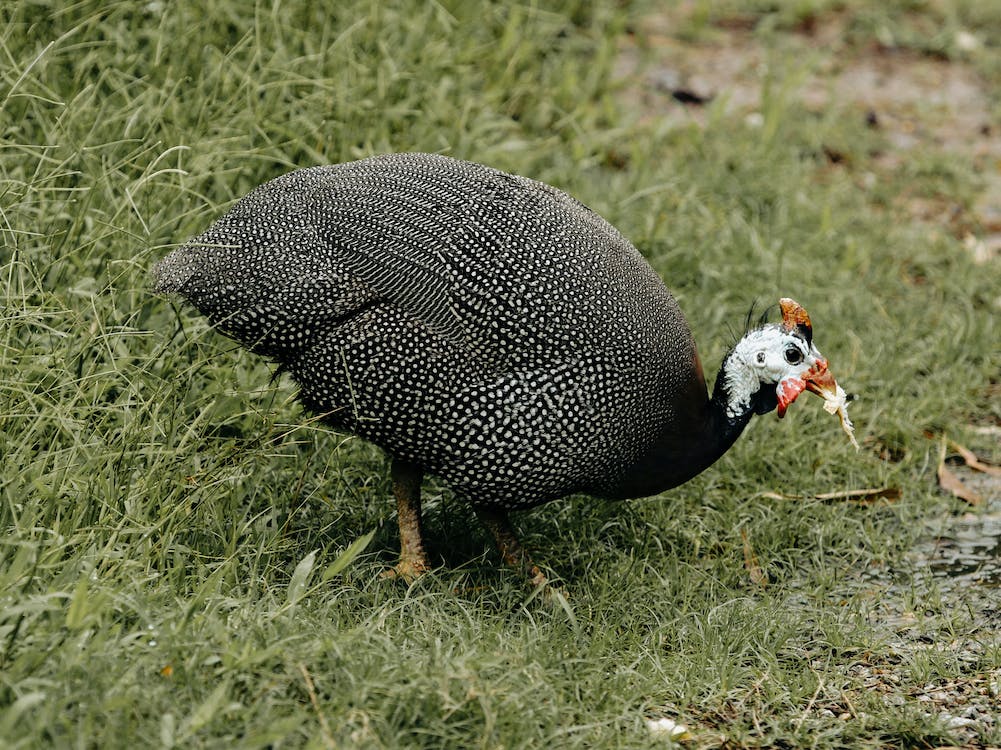The Helmeted Guineafowl, also known as Numida meleagris, is a famous guineafowl species categorized under the family Numididae, and the only species that belongs to the genus Numida. The Helmeted Guineafowl’s closest relatives include the White-breasted Guineafowl, Plumed Guineafowl, and Vulturine Guineafowl.
This species was first described in 1758 by Carl Linnaeus, a Swedish zoologist dubbed as the father of modern taxonomy due to his significant contributions to zoology.
There are nine recognized subspecies of Helmeted Guineafowl:
Gurney’s Helmeted Guineafowl – This subspecies occurs in eastern and central South Africa and western Swaziland.
West African Guineafowl – This subspecies can be sighted in western Africa to southern Chad, northern Angola, and central Zaire.
Marungu Helmeted Guineafowl – This subspecies exists in the south Congo Basin, western Angola, and Zambia.
Saharan Helmeted Guineafowl – This subspecies occurs in eastern Chad, Ethiopia, northern Zaire, northern Kenya, and Uganda.
Tufted Guineafowl – This subspecies lives in Tanzania, Botswana, Zambia, northern Southern Africa, eastern Swaziland, and Mozambique.
Damara Helmeted Guineafowl – This subspecies occurs in southern Angola, northern Namibia, and Botswana.
Reichenow’s Helmeted Guineafowl – This subspecies is present in central Tanzania and Kenya.
Saby’s Helmeted Guineafowl – This subspecies only occurs in northwestern Morocco.
Somali Tufted Guineafowl – This subspecies lives in northeastern Ethiopia and Somalia.
The Handbook of the Birds of the World (HBW) states that the current population size of Helmeted Guineafowls number to more than 1,000,000 individuals. Because Helmeted Guineafowl and its subspecies occur in a wide range and their population is in a stable rise, the International Union for Conservation of Nature (IUCN) Red List categorized this species as Least Concern.
Its seven levels of scientific classification are as follows:
Kingdom: Animalia
Phylum: Chordata
Class: Aves
Order: Galliformes
Family: Numididae
Genus: Numida
Species: N. meleagris
The physical characteristics of a Helmeted Guineafowl
This species is a large ground-dwelling bird, measuring 53 to 58 centimeters in height and weighing about 1.3 kilograms. It has a small body and a large, round body. An adult Helmeted Guineafowl has a grey-black plumage sparkled with white spots all over. Like other guineafowl species, this species has an unfeathered head with red, black, and blue hues. Its wings are rounded and short, just like its tail. Subspecies mostly differ in shape, size, and color of facial wattles and casques.
The distribution and habitat of Helmeted Guineafowls
Helmeted Guineafowls are endemic to the African continent, which mainly occurs in the Sub-Saharan region. They have also been widely introduced into Brazil, New Zealand, Portugal, Cuba, Australia, United States, Syria, and Europe. They are sedentary birds who breed in semi-arid, warm, and open habitats with scattered trees and shrubs such as farmlands and savannahs.
The behavior of a Helmeted Guineafowl
Helmeted Guineafowls form flocks outside the breeding season, which makes them gregarious birds. They form flocks made of up to 25 birds that roost communally. They are sedentary and terrestrial, preferring to run than fly when threatened. Helmeted Guineafowls highly rely on gliding to travel extended distances because they have short-lived explosive flights.
Helmeted Guineafowls may not be great flyers, but they are excellent walkers and runners. They can walk over 10 km a day. They are diurnal birds, starting a day with a trip to a water hole, and then they will forage in flocks. A Helmeted Guineafowl has strong claws that enable it to scratch in loose soil to find prey. They rest, take shade, or have a dust bath during the hottest hours of the day.
Helmeted Guineafowls breed during spring and summer. During the dawn of the breeding season, a male Helmeted Guineafowl will associate itself with several females before pairing with one of them for life. Males are usually aggressive towards each other, sometimes partaking in aggressive fights that leave others injured.
The female Helmeted Guineafowl will lay 6-12 eggs, which will be incubated by the female alone. The male is responsible for feeding and guarding her during the incubation period, which usually lasts 26-28 days. The chicks, called keets, are precocial when hatched. They can leave the nest and forage for themselves within hours of hatching, but the parents will follow them closely. The keets fledge around 10-14 days after hatching.
The diet of a Helmeted Guineafowl
As omnivores, Helmeted Guineafowls feed on a variety and plant food. Their diet primarily consists of fruits, seeds, leaves, snails, worms, spiders, lizards, small snakes, small mammals, and other insects.
BOTSWANA BIRDS | SOUTH AFRICA BIRDS
NAMIBIA BIRDS | ZAMBIA BIRDS | ZIMBABWE BIRDS
